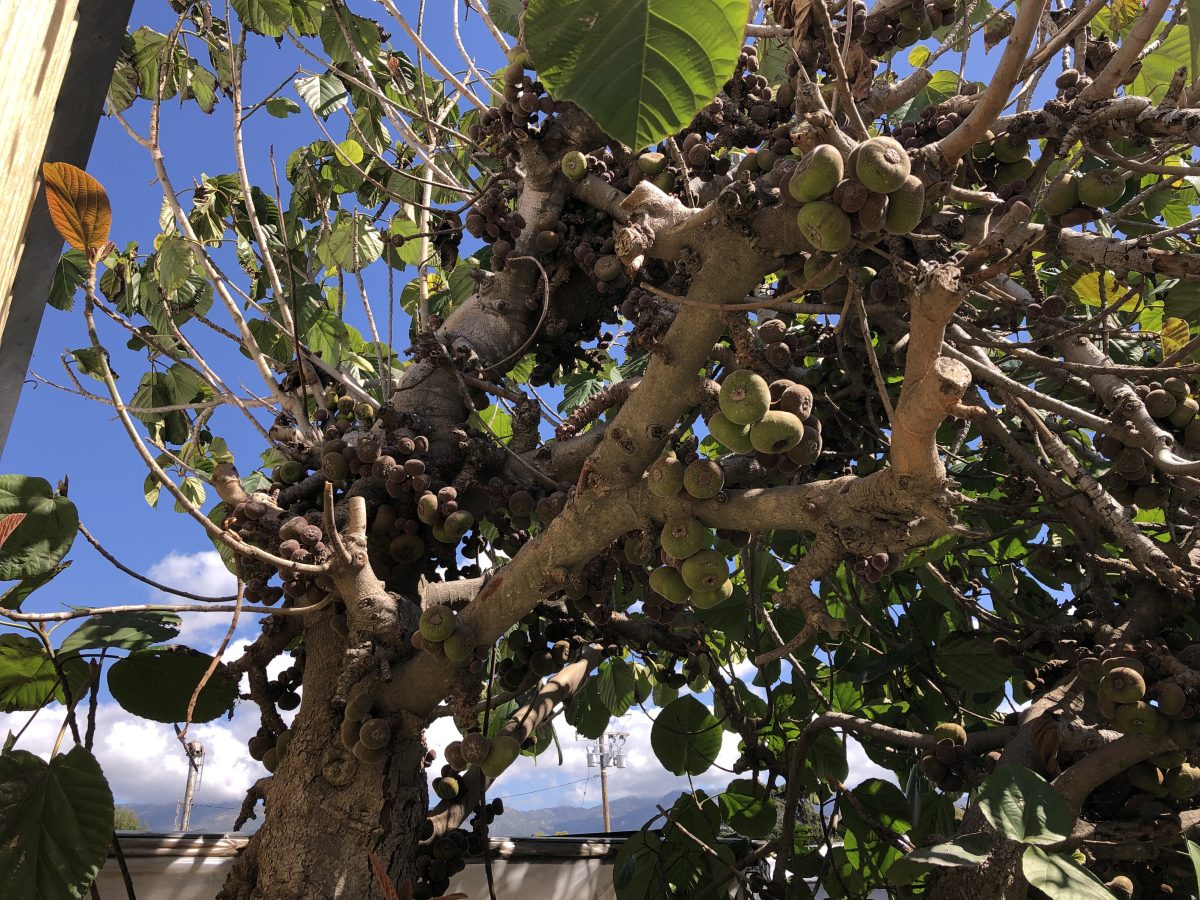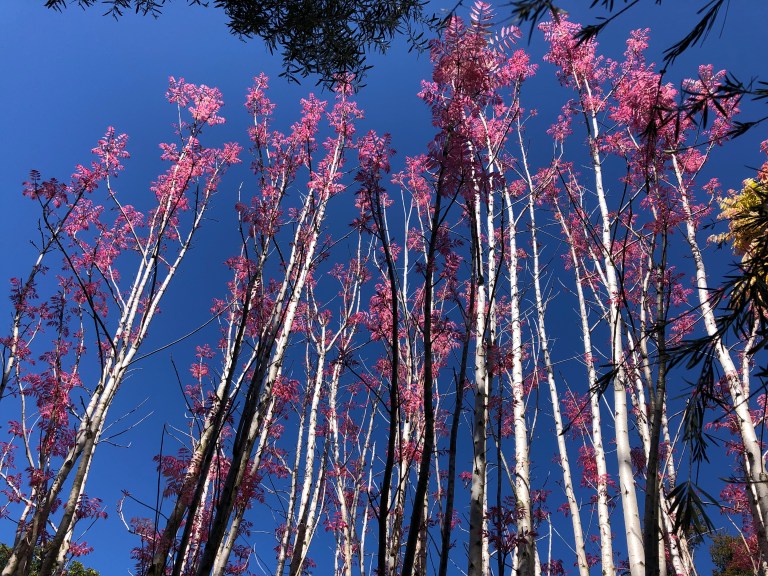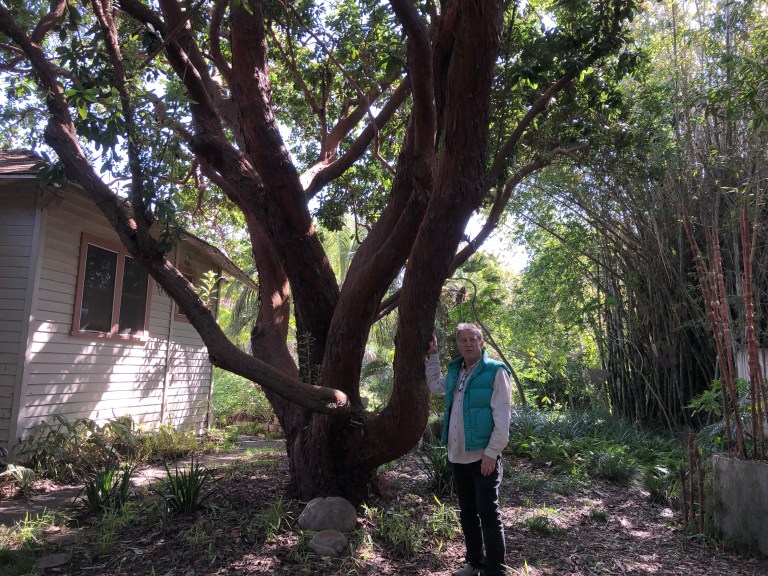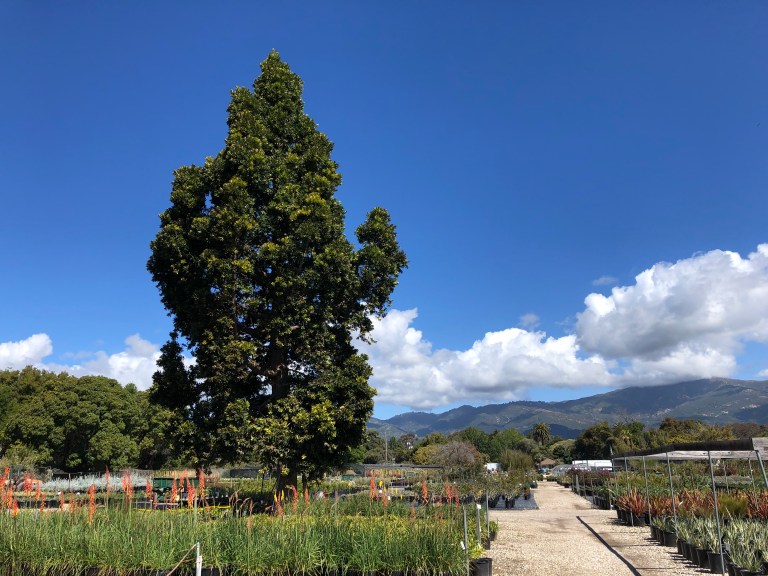San Marcos Growers: Where the Big Trees Roam
Not Just a Wholesale Nursery, but a Home to Extraordinary Trees

Toward the end of a tour around San Marcos Growers, the nursery’s general manager, Randy Baldwin, indicated an old, twisted fig tree growing by the greenhouses. “Cuttings from this tree have been planted all around Santa Barbara,” he said, mentioning a few locations, one of them immediately familiar: the corner of State and Figueroa Street where the tree with its button-shaped fruit and gnarled branches shares a planter at La Arcada with a brass fox.
San Marcos Growers has supplied generations of trees and plants to Santa Barbara and to contractors and professional landscapers throughout California for going on 45 years. Set in the Eastern Goleta Valley, the nursery is an agricultural oasis on busy Hollister Avenue. It sells on a wholesale basis only, with no retail sales, but some of its regulars are Disneyland and Lotusland, Baldwin said, as well as UC Santa Barbara. He employs about 50 sales and nursery staffers, growing the plants from seedlings and cuttings. Some of the trees on the property have been in the ground for a half century or more.
I’d come to see the giants, but it’s spring — as the wisteria growing along Highway 101 attests. What kept catching my eye were the unusual patterns to the branches and leaves of the plants at the nursery, and the incredible colors they displayed. Baldwin easily recalled their Latin and common names — as well as how they were spelled.

On our way to see one of the record-setting trees — the Arbutus ‘Marina’, or strawberry tree — a host of pink-leaved trees against the cerulean morning sky stopped me in my tracks.
“That’s a Toona sinensis,” Baldwin said of the white-barked trunks reaching 30 feet into the air. “You’ll see these at Alice Keck Park garden, where they keep them trimmed back,” he said, pointing to several stalks with pale pink leaves poking up through the undergrowth. “A related tree you’ll see in town is the Cedrela fissilis, or Brazilian cedar wood, also known as the ‘cigar box tree.’ It blooms along Gutierrez Street from Chapala to about Santa Barbara Street, but they’re usually a mass of green.”
The Arbutus ‘Marina’ is a madrone, with bark that peels back as it grows to reveal a deep-cinnamon-colored trunk. The one that Baldwin has grown is a national champion in Cal Poly’s California Big Tree Registry at nine feet around and 53 feet from leaf tip to leaf tip up at its height of 45 feet. That was in 2013, Baldwin noted, and it’s probably grown larger in the past decade.

Ken Knight, a well-known arborist in Santa Barbara, said the Cal Poly registry is run on behalf of the state, and its experts rate trees on a point system. The Arbutus became a champion with Baldwin’s nurturing: “Randy does a great job caring for trees,” Knight said.
He, Baldwin, and a few other people go out regularly to look for big trees. “It’s nice to have bragging rights until someone finds one bigger,” he said, laughing. The group had measured the Sister Witness tree together, Knight added, one of two immense sycamore trees across Hollister Avenue from each other, near Kellogg Avenue. The Sister tree was a Big Tree until someone claimed it was two trees, not one. Baldwin grows cuttings at the nursery from the Sister tree, which Knight said carried genetics from before the species cross-bred with sycamores introduced by Europeans. “They’re highly resistant to anthracnose, a fungal disease, and it’s important to keep that stock going.”

Not far from the champion Arbutus was a Canary Island palm, reaching 75 feet into the air. Baldwin thought the palm likely dated back to the historic period when the land began to be farmed by the Lane family in 1868. The Lanes still farm along Hollister Avenue right next to San Marcos Growers, on prime and unique agricultural lands, and have a popular produce stand down the block.
Baldwin arrived at the nursery in 1981, about three years after Marcia and Jim Hodges opened it on six acres on San Marcos Road. Jim Hodges was involved with Santa Barbara Beautiful and knew about the difficulty the city had locating trees to line its streets. He started the nursery with Dave Gress, who had been the city arborist and became the nursery’s first manager.

Baldwin said he was still a student at UC Santa Barbara when Marcia Hodges offered him the job — Jim Hodges had died unexpectedly — and he’s never looked back. He developed a website with photos and descriptions of the nursery’s trees, shrubs, and grasses, one of the first in the industry. The nursery now occupies 21 acres and has about 1,500 species of plants to keep track of. As we walked through a canopied area, Baldwin suddenly stopped to look at spirals of green with puffy white tips: “I didn’t know these were here!” he exclaimed.
The land had once been an experimental avocado orchard that extended back to El Camino School, which lies up toward the end of San Marcos Road. One of the relics from that age is the giant MacArthur avocado at the edge of a parking area, spindly with age but putting out new leaves and flowers. “That tree’s been there since about the 1940s or 1950s,” Baldwin said, “and we can still take cuttings from it.”
Under a canopy of tree branches, it gets hard for some of us to differentiate one tree from another. Baldwin and I stopped under the Quercus vaccinifolia, or huckleberry oak, which has unusually long thin leaves, and the Pittosporum viridiflorum, in bloom with a lightly honeyed scent. “These are probably the only specimens in the Goleta Valley,” Baldwin said.

Huge staghorn ferns hung from an even more huge magnolia tree not far away. Baldwin acknowledged it, too, was a giant for the area, possibly the biggest in town: “They grow larger in the Central Valley, though, and in Charleston, North Carolina, where they’re native.”
A Queensland kauri is the flip side of a magnolia; in the pine family, it grows relatively straight up, rather than sprawling laterally, and tolerates drought, as do all the plants the nursery grows. The kauri is native to Australia, and other plants at San Marcos Growers come from South Africa and the Mediterranean or are California natives. Baldwin has been able to grow the Queensland kauri from seed and has seen them planted at City College and Alameda Park. “They put caution tape around the trees when they develop cones,” he said, which are as large and heavy as croquet balls.
It was in the greenhouses where the magic of seed-to-plant and cutting-to-sprout that culminates in big trees could be seen. Amid rows and rows of pots and planters, Baldwin delivered some baby succulents he’d brought along and pointed out several ranks of kauri in small pots. “It takes about four years from seed to sale,” he said of the lanky evergreens that might someday grow from the leafy critters emerging from the soil. They were an affirming sight: Hope springs eternal in the growing world.

Correction: The trees along Gutierrez Street are Brazilian cedarwoods (Cedreal fissilis), not Chinese mahoganies (Cidrella sinensis).




You must be logged in to post a comment.